|
DPMS makes a very wide variety of AR style
rifles, probably more different variations than any other rifle
manufacturer. I own a few of the DPMS rifles, and find them to
be accurate, reliable weapons. My DPMS SASS-LRT .308 is the most
accurate rifle that I have ever fired, of any type. It will
consistently shoot into one slightly ragged hole at 200 yards,
from a good rest, with good ammo.
DPMS makes AR rifles chambered for the .204
Ruger, .223 Remington, 5.56x45mm NATO, .243 Winchester, .260
Remington, 6.5mm Creedmoor, 6.8mm Remington, .308 Winchester,
and .338 Federal cartridges. Hopefully, I did not miss
any. The only thing missing from their lineup is a big bore
thumper like the .50 Beowulf or .458
SOCOM. Other than that, DPMS has you covered for a quality AR
rifle.
The Pardus shown here is a very unique AR
style rifle. Operationally, it is pretty much like any modern
AR-15. The Pardus has no forward assist or ejection port dust
cover. Instead, it has sections of Picatinny rail in that area.
In fact, it has Picatinny rail in just about any area that has
room for it. Besides the flattop rail, there is a rail on each
side of the upper receiver, and the Pardus wears a four-rail
hand guard. The gas block also is topped with an integral
rail. There is plenty of room to mount a laser, flashlight,
vertical fore-grip, bipod, or whatever else you might want to
mount on an AR. In total, there are forty-four inches of
Picatinny rail on the Pardus rifle.
Unlike most AR rifles, the Pardus is not
primarily black, but wears a desert tan finish on the receivers,
hand guard, pistol grip, and buttstock. The magazine, barrel,
rear sling loop, charging handle, buttstock tube, magazine
release, and bolt release are finished in a dull black.
The trigger and bolt carrier are finished in a satin gold.
The Pardus weighs in at eight pounds, two
ounces with an empty thirty-round magazine in place. The barrel
is a straight bull profile, with a diameter of .884 inch and a
length of eighteen inches. There is an integral muzzle
brake machined into the barrel. In the video, I mentioned that
the Pardus has a match-grade trigger. That was not the best term
to use. The trigger pull feels much better than a standard AR,
but it still takes about five and one-half pounds of pressure to
release. It is really somewhere between a match trigger and a
standard trigger. I apologize for that statement, and that is
why I always urge folks to read the entire review, and to not
just watch the video. The buttstock is of the telescopic
style, and can adjust to fit most any shooter in any climate.
The Pardus is built to be a fighting rifle,
and for that reason, I mounted a Trijicon
ACOG scope atop its receiver. The ACOG is arguably the best
fighting optical sight in existence. It is very rugged, very
reliable, and has good, clear optics. The reticle is lit by
tritium for operations in low light conditions, and the
brightness is enhanced in sunlight by the fiber optic tube atop
the scope. In use, the reticle glows dimly in poor light, so as
to not overwhelm the target, but gets brighter as needed, and
can be seen very well, even in bright sunlight. The ACOG is
always “ON”, and never needs batteries. In Iraq and
Afghanistan, several optics are in use, one being the Aimpoint.
However, in talking with soldiers who have been over there, most
will trade their Aimpoints in for an ACOG when given the chance.
The TA33-H ACOG shown here has an amber circular reticle, with a
black bottom portion marked for long range use with the 5.56mm
service cartridge. The TA33-H has three power magnification, and
is very compact, having an overall length of six and one-eighth
inches, and weighing eleven ounces with flattop mount. The
housing is made of forged aluminum, and the reticle is etched
into the glass. I have a couple of ACOGs on my rifles, and have
used their 5.5 power model very successfully on targets out to
1125 yards. In my opinion, there is no better optic for a
fighting rifle that will used at short, medium, and long range
than the ACOG.
As mentioned above, there is no forward
assist on the Pardus, and I do not find that to be a problem. I
never use the forward assist on an AR. If a cartridge does not
fully chamber, there is a reason for that, and I would rather
get that cartridge out of there instead of trying to force it
in.
Shooting the Pardus was uneventful. It cycled
reliably, just as I expected that it would. I have owned and
fired a lot of DPMS rifles, and have never yet been disappointed
in the performance. The Pardus fed, fired, and ejected every
round perfectly. The adjustable buttstock was a bit stiff
to operate, but other than that, the rifle gave no problem at
all, and the buttstock operation became smoother as the testing
progressed.
Accuracy was very good. The Pardus grouped
well with everything fed it, but the Buffalo Bore Sniper ammo
turned in the best performance, grouping five shots into less
than one and one-quarter inches, repeatedly.
The Pardus comes with two thirty-round
magazines, a cleaning kit, and instructions, all packed into a
very good hard plastic case.
Check out the DPMS rifles online at www.dpmsinc.com.
To order DPMS rifles online, go to www.lowpriceguns.com.
For a look at the extensive line of quality
optics, go to www.trijicon.com.
Jeff
Quinn
|




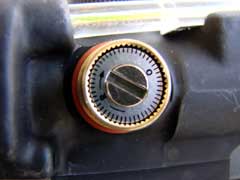
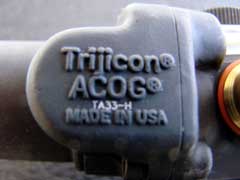
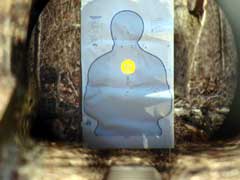
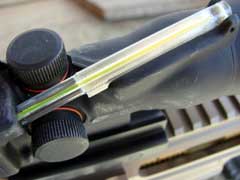

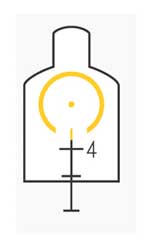
Trijicon ACOG TA33-H scope.
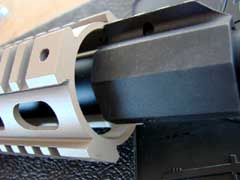
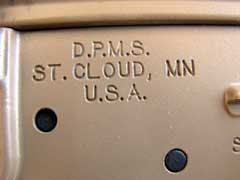
|
  
Got something to say about this article?
Want to agree (or disagree) with it? Click the following link to
go to the GUNBlast Feedback Page.
|
|
Click pictures for a larger version.
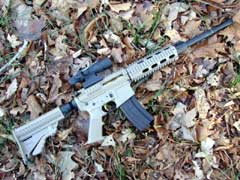
DPMS 5.56x45mm Pardus rifle with Trijicon ACOG scope.
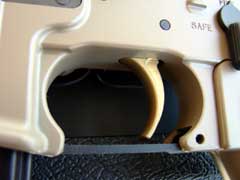

Trigger.

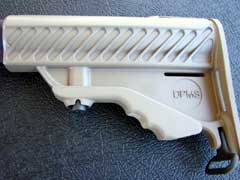
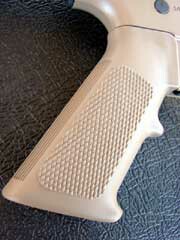
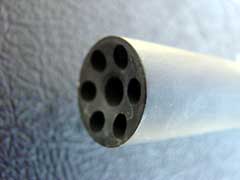
Integral muzzle brake.
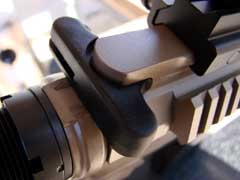
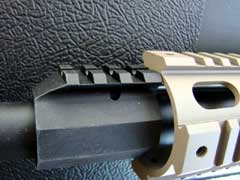
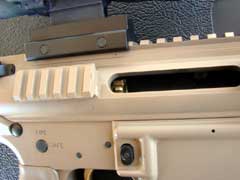
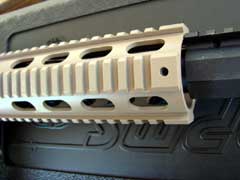
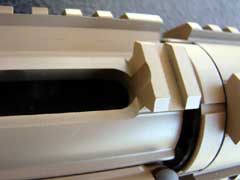

The Pardus has plenty of rails upon which to mount
stuff.

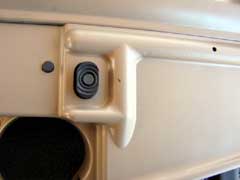
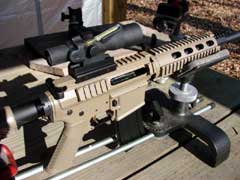

The Pardus proved to be quite accurate from the
bench.

|
![]()